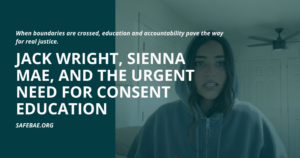Jack Wright, Sienna Mae, and the Urgent Need for Consent Education
When boundaries are crossed, education and accountability pave the way for real justice.
The Jack Wright and Sienna Mae Gomez Situation: Why It’s Back in the Spotlight
In early 2022, TikTok star Jack Wright released a YouTube video titled “What Sienna Mae Did to Me,” where he accused fellow influencer Sienna Mae Gomez of inappropriate touching and crossing personal boundaries without his consent. The allegations shocked their shared fanbase, as the pair had been close friends and collaborators, often appearing together in videos. Jack’s emotional account of these experiences shed light on issues of consent and power dynamics, especially among young influencers in the public eye.
Sienna Mae Gomez initially denied the allegations, releasing statements that countered Jack’s claims and framing their interactions as consensual. Over time, the controversy subsided, with both parties retreating from public discourse about the situation.
Recently, however, Sienna Mae Gomez reignited the conversation by releasing a new video addressing the accusations. In the video, she continues to deny the claims, framing her perspective as an attempt to clear her name and push back against the narrative that has defined her online persona since the allegations surfaced. Her video has sparked renewed debate across social media platforms, where supporters and critics on both sides argue over the truth of the situation and its broader implications.
This resurgence of attention highlights ongoing challenges in addressing allegations of sexual misconduct in the digital age. The rhetoric surrounding the situation—often laced with victim-blaming, misinformation, and polarization—has raised significant concerns about how these conversations are handled publicly and the harm they may cause, especially among impressionable young audiences.
The Need for Education: Addressing Boundaries and Accountability Among Youth
Sienna Mae Gomez’s perspective, as conveyed in her recent video, suggests that she believes Jack Wright exaggerated the situation and that the context of their relationship clears her name. However, the reality, as evidenced by the video Jack shared, is that a clear boundary was crossed. Jack was visibly unconscious, and regardless of the nature of their past interactions or touching, this moment demonstrates a lack of understanding about consent.
This scenario isn’t uncommon among youth. Many young people are navigating relationships and boundaries without the tools or education to fully understand the nuances of consent. Without proper guidance, situations like this arise—not out of malice, but out of ignorance. And when harm is caused, our culture often pushes those responsible to deny and deflect instead of reflecting and taking accountability.
In Sienna’s case, with a clearer understanding of what consent truly means and how boundaries are about respect and mutual awareness, she might have been able to recognize that her actions constituted a form of sexual assault. It wasn’t violent, and it doesn’t make her a monster. But it was harmful, and harm requires accountability. Unfortunately, in our society, admitting to a mistake often feels impossible, as it’s met with extreme backlash, legal threats, and social exile rather than a pathway to growth and understanding.
This is why education is critical. If conversations about consent, boundaries, and respect were normalized in schools, peer groups, and homes, young people would be better equipped to navigate these situations. They would understand that consent isn’t just about a verbal “yes” but about the ability to freely give that “yes” in the moment. They would learn that unconsciousness or coercion removes the possibility of consent entirely.
Equally important, they’d learn that accountability is not about punishment—it’s about acknowledging harm, understanding its impact, and making amends. By providing youth with this knowledge, we could prevent so many of these painful situations and help foster a culture where harm is addressed constructively, not defensively.
How SafeBAE’s Accountability Training Can Make a Difference
Situations like the one between Sienna Mae Gomez and Jack Wright underline the urgent need for meaningful accountability education. SafeBAE’s accountability training provides a framework that could help someone like Sienna not only recognize the harm caused but also take steps to make amends in a way that feels just and constructive for someone like Jack.
SafeBAE’s approach emphasizes education over punishment. It starts with helping young people understand what consent truly means: that it must be enthusiastic, ongoing, and freely given. Accountability training goes further by addressing the complexities of situations like this, where harm may not have been intentional, but it was still real and impactful.
In Sienna’s case, SafeBAE’s training could have given her the tools to reflect on her actions without defensiveness. She would have learned how to take responsibility for crossing Jack’s boundaries and acknowledge the harm caused, regardless of her intentions. This training also highlights that accountability isn’t about labeling someone as “bad” or “irredeemable” but about owning the impact of their actions and committing to growth and repair.
For someone like Jack, SafeBAE’s accountability process can provide a sense of justice that goes beyond public outrage or legal battles. The focus is on creating space for survivors to feel heard, validated, and supported. By centering the survivor’s needs, the process shifts away from adversarial blame and toward a constructive resolution that prioritizes healing.
This kind of education and accountability fosters a healthier culture among young people, where harm is acknowledged and addressed without defensiveness or denial. It teaches that admitting mistakes and working to repair relationships is not a sign of weakness but of strength and integrity. With programs like SafeBAE’s accountability training, we can prevent similar situations from escalating into years of pain, public backlash, and unresolved harm.
Dispelling Myths About Survivor Responses
One of the most damaging aspects of the conversation around sexual assault is the prevalence of harmful myths about how survivors “should” respond. Society often expects survivors to fight back or flee, creating a narrative that labels anything else—like freezing—as passive or weak. These misconceptions not only harm survivors but also perpetuate stigma and misunderstanding.
In reality, the freeze response is incredibly common among survivors of sexual violence. Research from the National Sexual Violence Resource Center (NSVRC) indicates that as many as 70% of survivors report freezing or feeling immobilized during their assault. This response, known as tonic immobility, is an involuntary reaction triggered by the brain’s fear response. It is not a choice or a reflection of a survivor’s strength but rather the body’s way of protecting itself under extreme stress.
These myths are further disproven by neuroscience. Studies show that the prefrontal cortex, responsible for decision-making, is often overridden during traumatic events. Survivors are not “choosing” to freeze; their bodies are doing what they’re biologically programmed to do to survive.
Instead of asking why someone didn’t fight back, we should focus on dismantling these harmful stereotypes and creating a culture of understanding. Survivors need to hear, “Your response was valid. You did what you had to do to survive.”
By embracing science and survivor stories, we can replace judgment with empathy. When we challenge these myths, we take a critical step toward supporting survivors and creating spaces where their experiences are met with compassion and respect.
A Survivor-Centered Path Forward
The situation between Jack Wright and Sienna Mae Gomez is a difficult reminder of how much work remains to be done in fostering a culture of understanding, education, and accountability. For survivors like Jack, it’s essential to know that their experiences are valid, their voices matter, and there are pathways to healing. For individuals who have caused harm, it’s equally important to understand that accountability is not about punishment—it’s about taking responsibility and committing to doing better.
At SafeBAE, we are committed to creating a world where these conversations are not just possible but commonplace. Our programs provide young people with the tools they need to understand consent, set boundaries, and take accountability when harm occurs. By educating and empowering youth, we can prevent situations like this and create a culture where survivors feel supported and justice is constructive.
If you’re ready to bring SafeBAE’s resources and programs to your community, now is the time to act. Together, we can educate the next generation, support survivors, and build a future where harm is addressed with empathy and integrity.
To learn more about SafeBAE’s accountability training, resources, or to support our mission, visit our website or contact us directly at info@safebae.org. Join us in creating safer spaces for all youth—because everyone deserves to feel safe, respected, and empowered.


